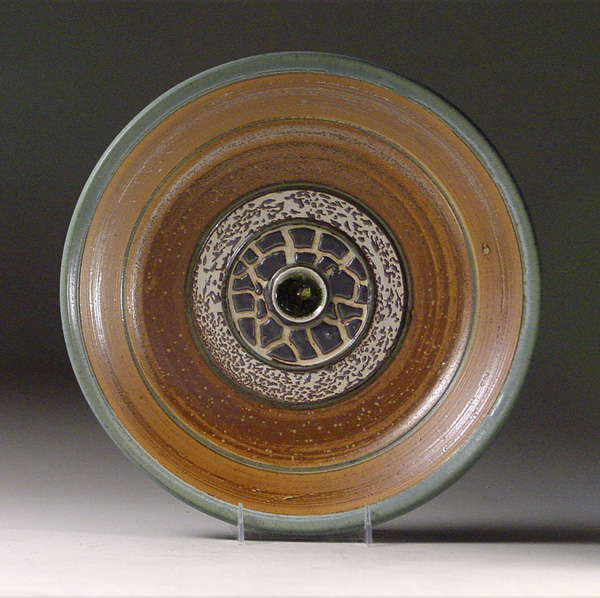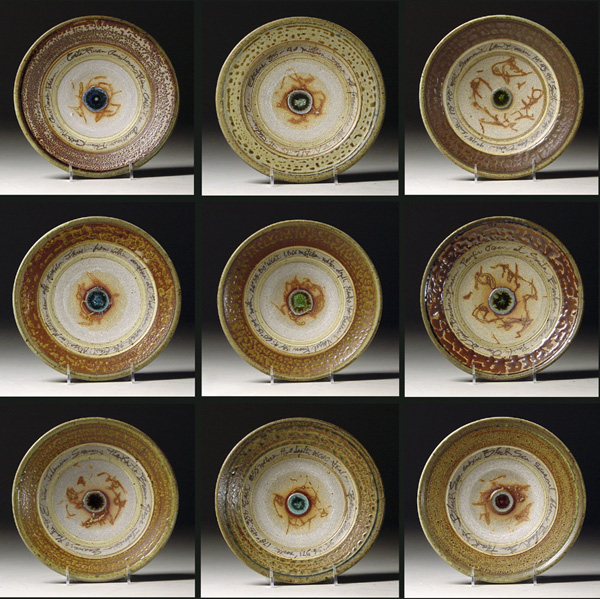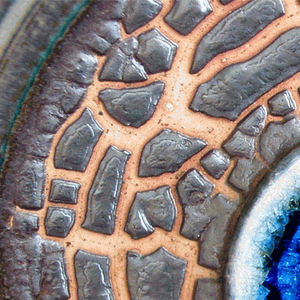As a potter I confront the conflation of art and science on a daily level. On the wheel I balance centrifugal force, gravity and the plasticity of clay. When I mix clay I consider particle sizes, geologic history, the location of origin and how the material acts in the wet state tensioned with how it appears once fired. In the kiln I collaborate with heat and fire, concerned with oxygen levels during combustion and cooling.
Potters continually mine their understanding of how materials shrink and melt, heat and cool and finally inhabit the kitchen and the table, our hands and our spirits. I find it particularly exciting to bring my material understanding down to its most elemental level by collecting materials that have not been processed for industrial use. These often contain impurities and variation. It allows me to feel not only like an artist and collaborator, but also like part mad scientist. I understand the rules of science and craftsmanship but break them in the same breath.
 Tuesday I attended a panel discussion at Georgetown University about art and science marking the opening of Where the Seafloor Melts with work by the ceramic artist Joan Lederman from Woods Hole, Massachusetts. Joan uses ocean floor sediments that are by-products of oceanographic research. Using these materials she creates artifacts or markers. She approaches science as an outsider and passionate amateur, beguiling us as a storyteller. She comes to her objects as a crafts-person.
Tuesday I attended a panel discussion at Georgetown University about art and science marking the opening of Where the Seafloor Melts with work by the ceramic artist Joan Lederman from Woods Hole, Massachusetts. Joan uses ocean floor sediments that are by-products of oceanographic research. Using these materials she creates artifacts or markers. She approaches science as an outsider and passionate amateur, beguiling us as a storyteller. She comes to her objects as a crafts-person.
 Joan discussed the coincidence of material coming to her door due to the generosity of a coastguard seaman and her proximity to the Woods Hole Oceanographic Institution, which has led to some unusual collaboration. The various forms of mud and ooze flowing across her doorstep have given her a material understanding on a molecular level and a global level due to mapping the origin-locations of her mud. She has had to wrap her imagination around geological history in a daily development of mind and memory. She perseveres in her studio experiments, working with the serendipity of what scientists contribute as well as an acceptance of what the kiln permits as she builds upon trial and error. Embedded in her objects is material knowledge and an artistic endeavor to document location, constructing a confluence of form, surface and variety.
Joan discussed the coincidence of material coming to her door due to the generosity of a coastguard seaman and her proximity to the Woods Hole Oceanographic Institution, which has led to some unusual collaboration. The various forms of mud and ooze flowing across her doorstep have given her a material understanding on a molecular level and a global level due to mapping the origin-locations of her mud. She has had to wrap her imagination around geological history in a daily development of mind and memory. She perseveres in her studio experiments, working with the serendipity of what scientists contribute as well as an acceptance of what the kiln permits as she builds upon trial and error. Embedded in her objects is material knowledge and an artistic endeavor to document location, constructing a confluence of form, surface and variety.
 It is when Joan steps outside the usual constructs of pottery craftsmanship, crossing the conventional line with materials that almost melt, that crawl or halo, overall creating poetic variations in surface texture, that they are the most interesting to my eye. Her documentation of heat work and place of origin show the work at its best. The fact that the melted materials are placed on a bowl or a cup or a vase seems almost incidental. There is room for more concept and collaboration of form and surface with the clay. The science has had so much to say there remains more untapped potential for the artistic side to come up to the podium and speak.
It is when Joan steps outside the usual constructs of pottery craftsmanship, crossing the conventional line with materials that almost melt, that crawl or halo, overall creating poetic variations in surface texture, that they are the most interesting to my eye. Her documentation of heat work and place of origin show the work at its best. The fact that the melted materials are placed on a bowl or a cup or a vase seems almost incidental. There is room for more concept and collaboration of form and surface with the clay. The science has had so much to say there remains more untapped potential for the artistic side to come up to the podium and speak.

Potters continually mine their understanding of how materials shrink and melt, heat and cool and finally inhabit the kitchen and the table, our hands and our spirits. I find it particularly exciting to bring my material understanding down to its most elemental level by collecting materials that have not been processed for industrial use. These often contain impurities and variation. It allows me to feel not only like an artist and collaborator, but also like part mad scientist. I understand the rules of science and craftsmanship but break them in the same breath.
 Tuesday I attended a panel discussion at Georgetown University about art and science marking the opening of Where the Seafloor Melts with work by the ceramic artist Joan Lederman from Woods Hole, Massachusetts. Joan uses ocean floor sediments that are by-products of oceanographic research. Using these materials she creates artifacts or markers. She approaches science as an outsider and passionate amateur, beguiling us as a storyteller. She comes to her objects as a crafts-person.
Tuesday I attended a panel discussion at Georgetown University about art and science marking the opening of Where the Seafloor Melts with work by the ceramic artist Joan Lederman from Woods Hole, Massachusetts. Joan uses ocean floor sediments that are by-products of oceanographic research. Using these materials she creates artifacts or markers. She approaches science as an outsider and passionate amateur, beguiling us as a storyteller. She comes to her objects as a crafts-person. Joan discussed the coincidence of material coming to her door due to the generosity of a coastguard seaman and her proximity to the Woods Hole Oceanographic Institution, which has led to some unusual collaboration. The various forms of mud and ooze flowing across her doorstep have given her a material understanding on a molecular level and a global level due to mapping the origin-locations of her mud. She has had to wrap her imagination around geological history in a daily development of mind and memory. She perseveres in her studio experiments, working with the serendipity of what scientists contribute as well as an acceptance of what the kiln permits as she builds upon trial and error. Embedded in her objects is material knowledge and an artistic endeavor to document location, constructing a confluence of form, surface and variety.
Joan discussed the coincidence of material coming to her door due to the generosity of a coastguard seaman and her proximity to the Woods Hole Oceanographic Institution, which has led to some unusual collaboration. The various forms of mud and ooze flowing across her doorstep have given her a material understanding on a molecular level and a global level due to mapping the origin-locations of her mud. She has had to wrap her imagination around geological history in a daily development of mind and memory. She perseveres in her studio experiments, working with the serendipity of what scientists contribute as well as an acceptance of what the kiln permits as she builds upon trial and error. Embedded in her objects is material knowledge and an artistic endeavor to document location, constructing a confluence of form, surface and variety. It is when Joan steps outside the usual constructs of pottery craftsmanship, crossing the conventional line with materials that almost melt, that crawl or halo, overall creating poetic variations in surface texture, that they are the most interesting to my eye. Her documentation of heat work and place of origin show the work at its best. The fact that the melted materials are placed on a bowl or a cup or a vase seems almost incidental. There is room for more concept and collaboration of form and surface with the clay. The science has had so much to say there remains more untapped potential for the artistic side to come up to the podium and speak.
It is when Joan steps outside the usual constructs of pottery craftsmanship, crossing the conventional line with materials that almost melt, that crawl or halo, overall creating poetic variations in surface texture, that they are the most interesting to my eye. Her documentation of heat work and place of origin show the work at its best. The fact that the melted materials are placed on a bowl or a cup or a vase seems almost incidental. There is room for more concept and collaboration of form and surface with the clay. The science has had so much to say there remains more untapped potential for the artistic side to come up to the podium and speak.
Leave a comment